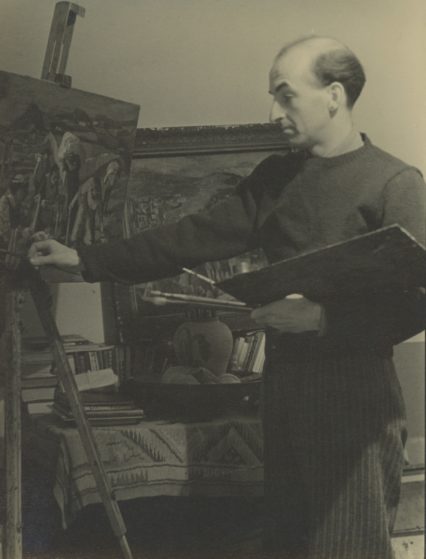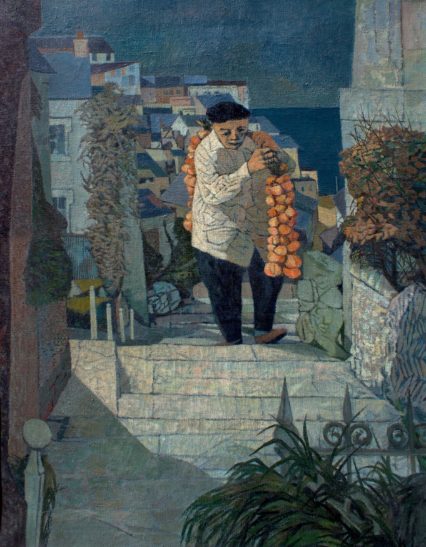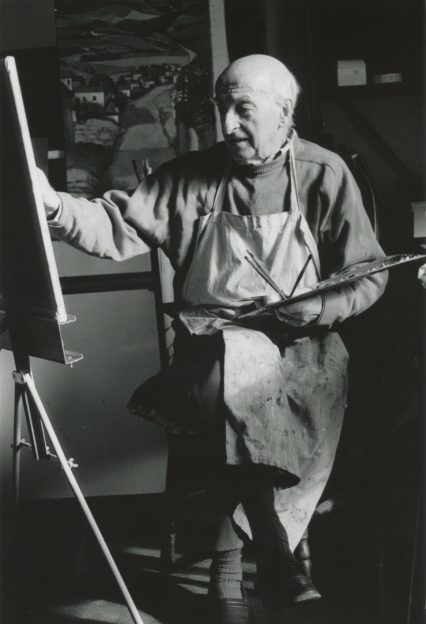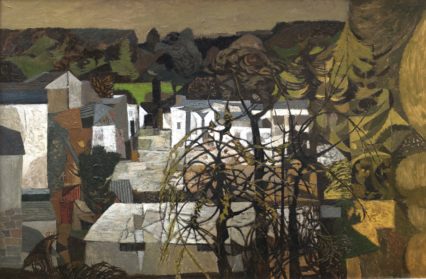 A crowded room. The audience listens attentively, not uttering a sound. Laughter. Professor Robert Meyrick, Head of the School of Art and Keeper of Art at Aberystwyth University, regales those assembled with tales of his friend the artist John Elwyn whose centenary is celebrated with this exhibition. Meyrick, who curated John Elwyn: A Quiet Sincerity, gives insights into the life and works of his friend as he recalls their times together at Elwyn’s Hampshire home and in Wales. After enthusiastic applause, the audience disperses to take a closer look at the paintings on show. The landscapes, scenes of village life, self-portraits and still-life assembled here have been loaned by a private collection. This exhibition provides a unique opportunity to see works rarely on public view.
A crowded room. The audience listens attentively, not uttering a sound. Laughter. Professor Robert Meyrick, Head of the School of Art and Keeper of Art at Aberystwyth University, regales those assembled with tales of his friend the artist John Elwyn whose centenary is celebrated with this exhibition. Meyrick, who curated John Elwyn: A Quiet Sincerity, gives insights into the life and works of his friend as he recalls their times together at Elwyn’s Hampshire home and in Wales. After enthusiastic applause, the audience disperses to take a closer look at the paintings on show. The landscapes, scenes of village life, self-portraits and still-life assembled here have been loaned by a private collection. This exhibition provides a unique opportunity to see works rarely on public view.
William “John Elwyn” Davies (1916-1997) was born in Adpar, Newcastle Emlyn, south Ceredigion, and was educated at Llandysul County Grammar School and Carmarthen School of Art. He took his final year at the West of England College of Art in Bristol. Afterwards he won a Royal Exhibition Scholarship to London’s Royal College of Art in 1938. As Meyrick explains, Elwyn was a “keen observer of people” which quickly becomes obvious in his depictions of rural Welsh life.
Although the artist spent most of his adult life in Hampshire, where he taught at the Schools of Art in Portsmouth and Winchester between 1948 and 1976, when it came to inspiration for his art, he always drew upon his experiences of Welsh rural life and village community: the ritual surrounding chapel going, farming, life in the countryside and the cycle of the seasons. Up to Date Gossip before the Meeting (1949) shows two women standing at the chapel vestry. Before they join the other participants, it seems that they want to exchange the latest scandals in private without being overheard. A scene, maybe not exclusive to the Welsh hinterland, but nevertheless quintessential. The Hymn Critics (1949) represents two gentlemen in their Sunday best pouring over a particular section in their hymn book. Whitsun Sunday Interval (1949) portrays a congregation gathering in the grounds of Newcastle Emlyn castle, catching up with friends and enjoying the late afternoon sunlight.
 The faces of Elwyn’s protagonists have almost caricature-like features, their expressions hinted at with only a few brush strokes and without fine detail. This doesn’t change even when the subject matter is more serious, as for example in News of a Pit Disaster in the Next Valley (1948). Here, villagers have gathered in the street, anxiously waiting for an update about an incident in a nearby mine. One woman is covering her mouth with a handkerchief as if to supress her crying; another is pressing her hand to her ear, possibly protecting it from the noise of the ‘hooter’ (steam whistle) that announces the event. However, Elwyn never fully caricatures his fellow Welshmen or makes them vulnerable to ridicule. He rather genially approaches them with his “gentle humour” which Professor Meyrick says was so typical for his friend. Their integrity and dignity remain intact.
The faces of Elwyn’s protagonists have almost caricature-like features, their expressions hinted at with only a few brush strokes and without fine detail. This doesn’t change even when the subject matter is more serious, as for example in News of a Pit Disaster in the Next Valley (1948). Here, villagers have gathered in the street, anxiously waiting for an update about an incident in a nearby mine. One woman is covering her mouth with a handkerchief as if to supress her crying; another is pressing her hand to her ear, possibly protecting it from the noise of the ‘hooter’ (steam whistle) that announces the event. However, Elwyn never fully caricatures his fellow Welshmen or makes them vulnerable to ridicule. He rather genially approaches them with his “gentle humour” which Professor Meyrick says was so typical for his friend. Their integrity and dignity remain intact.
The artist’s sense of humour is also present in his some of his landscapes. The Adventurer (1954) depicts a rather doomed-looking rough landscape with subdued shades of green, red and grey. Among the hills, a path leads into the distance. Dark storm clouds pass and light breaks through shaped like the wings of an avenging angel. On the track, cows make their way home. One of them lags behind; is she considering going her own way, experiencing something new and unknown rather than returning to the familiar cowshed? The title implies that cattle also might want to break away from the daily grind and this lightens the mood of the work. Or is it possible that Elwyn is suggesting that there is an exciting world outside the rural community waiting for those who dare to leave their safe surroundings behind?
Elwyn’s paintings are free of malice or criticism. Instead, they hint at a certain nostalgia for bygone days and a regret for the growing loss of community spirit. Fellow Welsh painter Sir Kyffin Williams RA remarked that “John was a clear-headed man who looked at his own world of Wales and loved what he saw. Heloved the people, the farms, the chapels, the winding roads and the small and tidy fields and guided by this obsession he gave to Wales something of great worth.”
 The artist’s sentiment seems to be shared by the majority of the visitors at the opening night. The reactions are overwhelmingly positive, and many present Welsh men and women are reminiscing about their own long-gone childhoods or Sundays spent at chapel services. Relative newcomers to Wales – such as the author of this article – who lack these memories, can immerse themselves in the lush greens and golden hues of Elwyn’s landscapes or imagine having a friendly chat with the farmer’s wife feeding the chicken in The Farmer’s Wife (1953). If there was any criticism at all that this reviewer is aware of, it was regarding Sioni Winwns (1958), a painting of a Breton onion seller doing his rounds in Newquay. These tradesmen would come over from Brittany every summer and sell their vegetable in the villages around the Cardigan Bay area. A lady who remembered those characters pointed out that the ‘Sioni’ in the picture was missing their typical tie, while a French friend commented that the explanation on the label of how the oignon rose de Roscoff were tied together was not the way she remembered it from her home country.
The artist’s sentiment seems to be shared by the majority of the visitors at the opening night. The reactions are overwhelmingly positive, and many present Welsh men and women are reminiscing about their own long-gone childhoods or Sundays spent at chapel services. Relative newcomers to Wales – such as the author of this article – who lack these memories, can immerse themselves in the lush greens and golden hues of Elwyn’s landscapes or imagine having a friendly chat with the farmer’s wife feeding the chicken in The Farmer’s Wife (1953). If there was any criticism at all that this reviewer is aware of, it was regarding Sioni Winwns (1958), a painting of a Breton onion seller doing his rounds in Newquay. These tradesmen would come over from Brittany every summer and sell their vegetable in the villages around the Cardigan Bay area. A lady who remembered those characters pointed out that the ‘Sioni’ in the picture was missing their typical tie, while a French friend commented that the explanation on the label of how the oignon rose de Roscoff were tied together was not the way she remembered it from her home country.
The gallery itself is small but well used. In the centre, there are three leather armchairs and a small table enclosed by two display cases that contain studio paraphernalia that had once belonged to Elwyn. Here the visitor has a very personal glimpse of the artist’s life and work. Among family photos and preparatory drawings for commercial assignments, are also letters from John Elwyn and Kyffin Williams to Robert “Bob”. Elywn’s palette, his brushes and work apron are included as well. The painter’s beautiful wooden easel, supporting his Portsmouth Still Life (1949), completes a setting that creates an almost homely feeling, tempting the visitor to linger just for a little longer and perhaps browse John Elywn’s biography – written by Robert Meyrick – that is laid-out on the table.
John Elywn:’A Quiet Sincerity’ will be open until the 17th February 2017, Monday-Friday 10:00am to 5:00pm (closed 22/12/2016 – 05/01/2017). The School of Art Gallery is located in the Edward Davies Building on Buarth Mawr, Aberystwyth (SY23 1NG).












